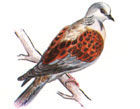
Characteristics
urtle doves are a small, migratory summer Columbidae, so they only stay in Tenerife in spring and summer. They arrive on the Island in mid-March and most return to the African continent in September. They measure around 27 centimetres and weigh 150 grammes. The upper part of the plumage is brown and orangey coloured, and the chest is pinkish. They have a black open collar (three lines) with white stripes on either side of the neck. The tail is slate grey ending in a strip of white. Their profile is graceful and their flight powerful and swift. They look for seeds in open spaces and choose copses for resting, roosting and shelter.
Ecology
Shunning urbanised areas, they choose agrarian habitats, preferably fruit crops and open pastures where they can find shelter and food. The best habitats for turtle doves are areas of land where a patchwork pattern of copses alternates with cereal crops, and sunflowers and rapeseed grown for industrial purposes. The habitat gains in quality if fruit trees grow along the edges of fields. Habitats with tall bushes (taller than 1.5 m) are excellent if they have barren patches with thistles.
Turtle doves eat all sorts of different seeds and small to medium size grain. They do not hesitate to travel long distances to find food in the best places (they need open ground), to drink or to find the right perch.
Social organisation and reproduction
Turtle doves arrive in small groups, and subsequently form pairs. Chicks integrate into the bands that gather in the areas that afford food and shelter. That is how they start gathering into bands for migration. Migratory bands look for halfway stations areas where they can rest and feed before continuing their migratory journey. They lay eggs twice a year from May to June in a rudimentary nest.
They lay two eggs that both parents incubate for around 14 days. Then the parents feed their young for 18 days. Gathering into bands is essential for finding the best sources of food, water, places to roost and shelter. This strategy enables them to diminish the impact of predators. They emigrate from September to October, after the reproduction season, to spend the winter on the African continent.
The turtle dove population has diminished at an alarming rate in recent decades. Certain groups of ecologists and hunters have requested a moratorium on turtle dove hunting. Studies conducted in Tenerife have provided evidence of reproductive failure in transition (ecotone) areas, possibly owing to the impact of predation by rats and cats.
Hunting management
There are plans to constitute a hunting association for the conservation and management of common turtle doves. Currently there is no data on their use for hunting purposes.


 Print
Print